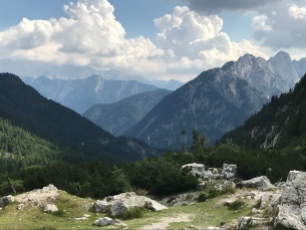It’s been a hundred years since the end of World War I—an appropriate time to highlight some books I read this year on this subject. The books are all different—the main characters have different nationalities and the books are set in different locations—providing an interesting perspective.
World War I has always appeared as a messy affair to me. First, the Austro-Hungarian Empire declared war on Serbia, and based on alliances, other countries joined in; with Britain, France, Russia, Italy and the US on one side and Germany, Austria-Hungary and the Ottoman Empire on the other. Eight and half million soldiers and seven million civilians lost their lives in the span of four years.
But a book usually focuses on one region. Let’s start with The Alice Network by Kate Quinn. It’s set in France during World War I (and World War II) and embraces the role women played in it. The book has two closely connected storylines. In 1947, we get to know Charlie, an American girl trying to locate her French cousin, who is presumed dead. In 1915, we follow Eve, who works as a spy for the Alice Network in France during World War I.
I liked the story set in 1915 the best. The danger of Eve’s job, the double standards she had to deal with as a woman in her profession, her resourcefulness and bravery, all made it impossible for me to put the book down. I don’t know as much about World War I as I would like, and I certainly didn’t know about the Alice Network. The afterword by Kate Quinn is a wonderful addition; much of the book is based on true events.
It’s so easy to ignore women in history who did amazing things. Because, let’s face it, back in the beginning of the 20th century women weren’t supposed to do “amazing things.” The women who were part of The Alice Network, lived in a time in which they were still not allowed to vote, yet they showed themselves capable enough to spy on the enemy and put their lives at risk. For me, Eve’s story alone made this book an excellent read.
As Kate Quinn explains in the afterword, the Alice Network and Alice Dubois, or Louise de Bettingies, really existed. She organized a vast and highly effective network of informants in the area of Lille. Louise was captured by the Germans in 1915, and died in prison in 1918, before the end of the war.
My interest wsparked by reading The Alice Network, led me to pick up a classic describing life in the trenches: All Quiet on the Western Front by Erich Maria Remarque (written in 1927). Mr. Remarque himself was a soldier on the German side. Instead of glorifying the war, his descriptions of the carnage and total despair these men faced, paint a vivid picture of the utter madness of war. In a few passages, he flat-out taunts the people in power, questioning why the common men always end up fighting a war that was not theirs to begin with. Not surprisingly, the book was forbidden by the Nazi regime. Mr. Remarque had to flee Germany soon after publishing it and in 1938 his German citizenship was revoked.
Some of the areas of fighting in West-Europe, initially nothing but scarred fields of mud and craters, were cordoned off after the war and have since then developed into lush forests, but unfortunately, some are still littered with (unexploded) shells. Other areas apparently are still toxic, containing high levels of arsenic. For reference, check out this article in the Atlantic.
I have never visited any of the battlefields in West-Europe, but this summer we went to Slovenia and Italy, where there was extensive fighting as well. Triglav National Park, in Slovenia, is a beautiful mountainous area—you can hardly imagine its bloody history while enjoying the amazing views of emerald rivers, pristine waterfalls and rocky mountain tops. My daughter decided that if there are fairies, they’d be sure to live in this place.
The fairies may have thought differently a hundred years ago. An estimated 300,000 soldiers died and 700,000 were wounded on the Soča Front. The Italians invaded this part of Slovenia to open up the way to Vienna, but instead faced years of fighting the Austro-Hungarian army uphill. Then, in 1917, a German offensive blew right through the Italian defenses. The battle of Kobarid (Coparetto) and the following retreat has been well described in A Farewell to Arms by Ernest Hemingway, who himself was an ambulance driver in this area during the war.
I read A Farewell to Arms during high school, but I will admit it was kind of lost on me at that time, and I discarded it as a depressing love story. Having reread the book after our visit to Slovenia and Italy, I can say I appreciate his writing style and tone a lot more than I did when I was younger. The love story was still very sad, but having a better sense of the places he described deepened the reading experience.
It’s been a hundred years—how easy it would be to stop remembering. But if we let time erase the memories of the horrors of war, who is to stop us from making the same mistakes over and over again? These three books are all poignant tales that will ensure you won’t forget.




 The book is set in the world war II era, as well as the post-war years; a familiar theme. However, what sets this story apart is that it revolves around three women, three German women—each experiencing the war differently—but all scrambling for survival afterwards. As fate binds them together, they take care of one another and their children, trying to find a better life.
The book is set in the world war II era, as well as the post-war years; a familiar theme. However, what sets this story apart is that it revolves around three women, three German women—each experiencing the war differently—but all scrambling for survival afterwards. As fate binds them together, they take care of one another and their children, trying to find a better life.
 The Lover’s Portrait written by Jennifer S. Alderson, was a fun and exciting read!
The Lover’s Portrait written by Jennifer S. Alderson, was a fun and exciting read! andmaid’s Tale by Margaret Atwood
andmaid’s Tale by Margaret Atwood One of the reasons I pick up a book about World War II every now and then is because they are such good reminders of the more recent horrors of our history. If we do not learn from our history, then how are we to prevent ourselves from making the same mistakes over and over again?
One of the reasons I pick up a book about World War II every now and then is because they are such good reminders of the more recent horrors of our history. If we do not learn from our history, then how are we to prevent ourselves from making the same mistakes over and over again? captivated till the end. It is about a group of farm animals living at Baxters’ Barn, who learn about their farmer’s plan to set fire to the barn. They try to make their escape, which can only work if they help one another. Even though insurance fraud is a concept not known to many 8 year olds, it only comes up at the end, and surprisingly enough, it was very easy to explain. One of the things that most struck me about the book was how descriptive it was; everything was described so well, it was easy to imagine the barn, the surroundings, the animals and their peril—but it was done so without trying my child’s patience or scaring him out of his wits. Thank you, Rebecca Bond, for writing this book, and providing for many nights of enjoyment and bonding.
captivated till the end. It is about a group of farm animals living at Baxters’ Barn, who learn about their farmer’s plan to set fire to the barn. They try to make their escape, which can only work if they help one another. Even though insurance fraud is a concept not known to many 8 year olds, it only comes up at the end, and surprisingly enough, it was very easy to explain. One of the things that most struck me about the book was how descriptive it was; everything was described so well, it was easy to imagine the barn, the surroundings, the animals and their peril—but it was done so without trying my child’s patience or scaring him out of his wits. Thank you, Rebecca Bond, for writing this book, and providing for many nights of enjoyment and bonding. Kristin Hannah’s The Nightingale is a wonderful book that hardly needs more publicity, but I will gladly give it. I couldn’t stop reading until I finished it. Set in WWII, it tells the story of two sisters, each dealing in their own way within German-occupied, war-torn France. As it states on Amazon:
Kristin Hannah’s The Nightingale is a wonderful book that hardly needs more publicity, but I will gladly give it. I couldn’t stop reading until I finished it. Set in WWII, it tells the story of two sisters, each dealing in their own way within German-occupied, war-torn France. As it states on Amazon: